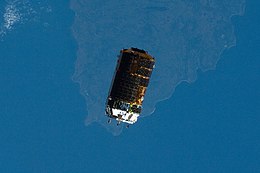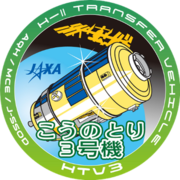Kounotori 3

Kounotori 3 approaches the ISS on 27 July 2012
|
|
| Mission type | ISS resupply |
|---|---|
| Operator | JAXA |
| COSPAR ID | 2012-038A |
| Spacecraft properties | |
| Spacecraft type | HTV |
| Launch mass | 19,000 kilograms (42,000 lb) |
| Start of mission | |
| Launch date | 21 July 2012, 02:06:18 UTC |
| Rocket | H-IIB |
| Launch site | Tanegashima Yoshinobu-2 |
| Contractor | Mitsubishi |
| End of mission | |
| Disposal | Deorbited |
| Decay date | 14 September 2012, 05:27 UTC |
| Orbital parameters | |
| Reference system | Geocentric |
| Regime | Low Earth |
| Inclination | 51.6 degrees |
| Berthing at ISS | |
| Berthing port | Harmony nadir |
| RMS capture | 27 July 2012, 12:23 UTC |
| Berthing date | 27 July 2012, 14:34 UTC |
| Unberthing date | 11 September 2012, 11:50 UTC |
| RMS release | 12 September 2012, 15:50 UTC |
| Cargo | |
| Mass | 4,600 kilograms (10,100 lb) |
|
|
|
Kounotori 3 (Japanese: こうのとり3号機; English: "white stork"), also known as HTV-3, is the third Japanese H-II Transfer Vehicle. It was launched on 21 July 2012 to resupply the International Space Station (ISS) aboard the H-IIB Launch Vehicle No. 3 (H-IIB F3) manufactured by MHI and JAXA. Kounotori 3 arrived at the ISS on 27 July 2012, and Expedition 32 Flight Engineer and JAXA astronaut Akihiko Hoshide used the International Space Station’s Canadarm2 robotic arm to install Kounotori 3, to its docking port on the Earth-facing side of the Harmony module at 14:34 GMT.
After the supplies are unloaded, Kounotori 3 was loaded with waste material from ISS, including used experiment equipment and used clothes. Then Kounotori 3 was unberthed from the ISS on September 11 and burned up upon reentering the atmosphere on September 14, 2012.
Major changes of Kounotori 3 from previous Kounotori are:
Ground operation was improved to allow more late access cargo.
Kounotori 3 carries approximately 4.6 tonnes cargo, consisting of 3.5 tonnes in pressurized compartment and 1.1 tonnes in unpressurized compartment.
Pressurized cargo consists of system equipment (61%), science experiments (20%), food (15%), and crew commodities (4%). It includes: Aquatic Habitat (AQH), JEM Small-Satellite Orbital Deployer (J-SSOD), five CubeSats (RAIKO, FITSAT-1, WE WISH, F-1, TechEdSat), i-Ball and REBR reentry data recorders, ISS SERVIR Environmental Research and Visualization System (ISERV). Additionally, loaded onto Kounotori 3's Resupply Racks was NASA’s Water Pump Assembly (WPA) catalytic reactor to replace the former unit that broke in March 2012 in orbit and a cooling water circulation pump to replace the old unit in the Japanese Experiment Module (Kibo) that also broke at the end of March.
...
Wikipedia

